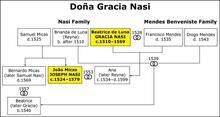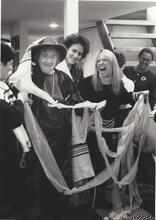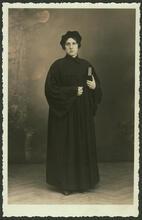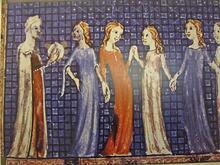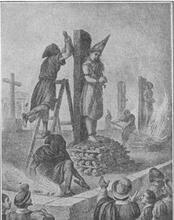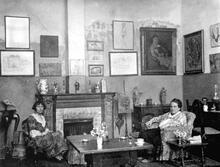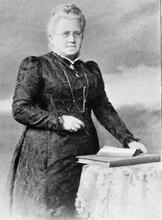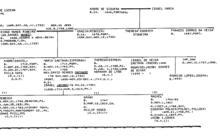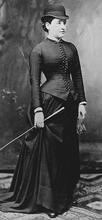Female Martyrdom
Jewish women in various eras have chosen to die rather than repudiate God or transgress certain commandments. Such martyrdom, or Kiddush haShem (sanctification of the Divine Name), generally involves public acts intended to exhort other Jews and confound persecutors. Female martyrs appear in Jewish Hellenistic and rabbinic texts, chronicles of the medieval Crusades and seventeenth-century Chmielnicki pogroms, and Shoah-related documents. Such narratives reflect actual horrific events, but many researchers consider martyrological representations to be more mythic and emblematic than historical. Scholars point to didactic glorifications of female martyrs; evocations of biblical and post-biblical exemplars such as Rachel, Esther, and the mother of seven sons (2 and 4 Maccabees); the frequent motif of drowning to avoid sexual defilement (bGittin 57b); and elements from the majority Christian culture.
Martyrdom in Jewish Tradition
Martyrdom in Judaism is most often understood as choosing death instead of repudiating belief in the oneness of God or disobeying certain divinely imparted commandments. Martyrdom also has a public component: Kiddush HaShem, or sanctifying the divine name, is exemplary to the larger Jewish community at the same time as it profoundly repudiates the convictions of the persecutors. In various eras, martyrs, both female and male and of different ages and occupations, have been venerated and appealed to as intercessors on behalf of individuals and entire communities. Over time, narratives about martyrs have been reshaped in formulaic ways that evoke characters and episodes from biblical and rabbinic literatures; often such accounts incorporate elements from the majority culture as well. Thus, it can be challenging for researchers to discover historical kernels in tendentious accounts meant to enhance faith.
Female Martyrs in Late Ancient Judaism
Martyrdom first appears in Jewish writings in the Hellenistic era (332 B.C.E. – 30 B.C.E.). While most martyrs in these texts are male, 2 Maccabees 7 and 4 Maccabees 8-17 recount the narrative of the mother who exhorted her seven sons to resist orders to eat pork and to worship Seleucid king Antiochus IV. She witnessed their successive martyrdoms before embracing death herself through suicide. This woman, unnamed in the earlier accounts, is identified as Miriam bat Tanhum in rabbinic sources (BT Gittin 57b; Lamentations Rabbah 1:16, §50) and as Hannah in a late medieval Spanish version of the popular Hebrew chronicle, the Book of Josippon. In 4 Maccabees 17:2-6, in a passage invoking the divine blessing that followed Abraham’s binding of Isaac (Gen 22:15-18), the mother is assured that her children will be numbered among the stars, “For your sons were true descendants of father Abraham.”
The Hebrew term Kiddush HaShem was first applied to martyrdom in rabbinic times (1st century C.E. to c. 600 C.E). Rabbinic authorities, caught between the primacy of preserving life and the necessity of devotion to God, established parameters for martyrdom. They ordained that it was preferable to transgress commandments rather than be killed. The only exceptions were in cases of idolatry, sexual misconduct, and homicide (BT Sanhedrin 74a–b, JT Sanhedrin 3:6, 21b; Shepkaru). The Babylonian Talmud, at Gittin 57b, praises instances of martyrdom in such situations, and several of the examples cited include female protagonists, among them the mother and her seven sons. bGittin 57b also recounts the voluntary martyrdoms of 400 girls and boys who were being transported to Rome to be consigned to brothels. According to this narrative (which also appears in a somewhat different version in Lamentations Rabbah 1.16 §45), the girls drowned themselves, assured that they would attain life in the world to come by the biblical promise, “The Lord said, ‘I will retrieve from Bashan,/ I will retrieve from the depths of the sea’” (Ps 68:23). The text then relates that the boys also jumped into the see reasoning, “If these, for whom this [that is, the passive role in intercourse] is natural, act so, shall not we, for whom it is unnatural?” The anecdote concludes by citing Psalm 44:23: “It is for your sake that we are slain all day long/ that we are regarded as sheep to be slaughtered.”
The Spanish philosopher, scientist, and historian Abraham Ibn Daud (ca. 1110-1180) evoked this narrative in his chronicle Sefer Ha-Kabbalah (book of tradition), written in the 1160s, when he relates the fate of the wife of one of four captive rabbis. Rather than be violated by the captain of the ship on which they were travelling, and reassured by her husband’s quotation of Psalm 68:23, she, too, jumped into the sea. In fact, the theme of suicide by drowning is a frequent motif in accounts of female martyrdom.
Medieval Crusade Narratives and Female Martyrdom
Jewish martyrdom was a recurring event in the Christian Middle Ages, and women are mentioned by both Jewish and Christian chroniclers in the forefront of those who chose death over forced conversion. Three Hebrew chronicles, written in the half century after the events they describe, recount attacks on Jewish communities in Northern France and Germany during the First Crusade of 1096; they all extol female martyrs – many of whom are mentioned by name – as active exemplars of devotion under ultimate stress. Avraham Grossman has written of these documents, “There is no other genre in the medieval Jewish world in which women occupy such an important and central place, and are portrayed in such a sympathetic and admiring manner” (Grossman, 198). The extraordinary performances of female piety described in these literary works include young women who choose death, in some cases by drowning themselves, over conversion and marriage to gentile men of high rank. The chronicles also portray mothers who kill their children in order to save them from the greater evil of conversion, and older independent businesswomen who remain true to their faith despite Christian encouragements to convert and save their lives.
Scholars have argued that such exalted representations indicate the high status of women in medieval Jewish society in Germany and Northern France, and they note that the female martyrs in these writings are described as “holy” and “pure,” as “daughters of kings,” and as actively choosing to sanctify God’s name by their deaths (Grossman, 198). It is striking that Christian accounts of some of these martyrdoms also depict Jewish women’s resolve in refusing to abandon Judaism and in dissuading their husbands from becoming Christians.
Other documents portraying female martyrdom include the Sefer Zekhirah (book of remembrance) of Ephraim of Bonn (1132-1196), a chronicle that details persecutions of Jews between 1146 and 1196 in England, France, and Germany, many in connection with ritual murder accusations. In addition, a corpus of poetry, mostly in Hebrew, written in the twelfth and thirteenth centuries also bears witness to these martyrdoms. Women were among the victims in most of these events; seventeen women, including the prominent moneylender Pulcellina, were among 30 martyrs killed in Blois in 1171.
Controversies Concerning Crusade Narratives
The large scholarly literature on Jewish martyrdom during the Crusades reveals substantial disagreements on a number of issues, including the historicity of the extant accounts and the actual number of Jews in Ashkenaz (Central and Western Europe) who chose conversion over martyrdom. Robert Chazan, among others, believes that the accounts are fairly accurate, particularly because the occurrences they describe “represent departures from prior modes of Christian and Jewish behavior and thought” (Chazan, 49). However, some researchers disagree. While they do not deny that horrific attacks on Jews in various locales resulted in significant loss of life, they assert that some of the martyrs’ actions described in literary accounts may be imaginative reconstructions that were intended to evoke the biblical akedah, the binding of Isaac in Genesis 22 (Marcus; Spiegel), the heroic role of the biblical Esther who risked her life to save her people (Marcus), and rabbinic traditions about the destructions of Jerusalem and the Jerusalem Temples (Cohen). These scholars suggest that the authors of the Crusade chronicles shaped their accounts of actual events to provide inspiring and didactic models for future generations.
It is also important to recognize that the medieval Jewish literature of martyrdom, which glorifies “beautiful deaths” and sometimes introduces miraculous elements into martyrdom narratives (Einbinder, 2002), was produced in a Christian society where sacrificial death and veneration of martyrs were central components of religious piety. Some scholars argue that Christian symbols and visual images played a significant role in shaping images of female martyrs. For example, multilayered traditions underlay the representation of the terrifying and bereft figure of Rachel of Mainz, whose murders of her four children are described in graphic detail in several crusade chronicles. Among these intersecting links are the biblical Rachel (both in the Genesis narratives and in Jeremiah 31:15, where the inconsolable Rachel weeps for her children) and the biblical Abraham (who bound his son for sacrifice). The chroniclers’ depictions of Rachel of Mainz, “lamenting the dead children on her lap,” evokes Christian representations of the Virgin Mary cradling the body of her crucified son. Jeremy Cohen writes that this account “demonstrates just how well immersed medieval Jews were in the culture of the Christian majority surrounding them, even in Northern Europe and even in times of violent conflict” (Cohen, 127). However, as Daniel Boyarin has detailed, Jews and Christians understood the components of female martyrdom quite differently; this is especially the case with the centrality of virginity in Christian martyrologies about women, a value that is absent from Jewish narratives.
In his thorough historiographical study of the representations of women in Hebrew and Latin accounts of the First Crusade, David Malkiel points out that historians have explained that women were placed in prominent roles in order to stress the universality of Jewish martyrdom. He notes that some have argued that the centrality of women’s acts of self-sacrifice is meant to emphasize “the spiritual triumph of Judaism over Christianity,” since “having women foil the enemy places the crusaders (and by extension Christianity) in a humiliating position, bolstering the morale of a Jewish audience” (Malkiel, 179). In addition, he writes that scholars have suggested that tales of women’s self-sacrifice were intended to encourage men to even greater acts. Malkiel also discusses the halakhic questionability of the performance of martyrdom in Ashkenaz, especially the slaughtering of spouses and children. He suggests that attributing leadership roles to women, “who were typically uneducated, and hence ignorant of talmudic law,” was one way around this highly problematic issue for the chroniclers. They could be depicted as acting “spontaneously, out of inner conviction or religious intuition, and did not imagine that they were committing a grave transgression” (Malkiel, 180).
Susan Einbinder points out that representations of women’s martyrdom by Jewish authors from the later twelfth and thirteenth centuries tend to emphasize female passivity and the vulnerability of women’s bodies to male assault. This contrasts with the admiring portrayals of women’s active agency in determining their own fates and those of their children that are so evident in the chronicles of the First Crusade. She writes that while differences in the portrayals of women over time may reflect the formulaic conventions of the poetic genre, they are also indications of the steady deterioration of women’s economic and social status in Ashkenaz. By representing women as “defenseless and violated,” or as individuals defined by their sexuality rather than their economic power, male authors rejected female agency and emphasized the patriarchal sanctity of familial bonds and religious authority (Einbinder, 2000: 127). Some scholars, such as Grossman, disagree with Einbinder’s contentions, but her arguments are compelling, particularly since efforts to diminish female autonomy and to limit women’s social, economic, and ritual activities are evident in contemporaneous Jewish legal writings.
Martyrologies in Ashkenaz and Sepharad
The memories of the events of 1096 and the actualities of subsequent persecutions and martyrdoms in the twelfth and thirteenth centuries led to the liturgical development of a cult of martyrs. These martyrologies, essentially lists of individuals murdered in outbreaks of oppression, were and continue to be recited in synagogue worship focused on remembrance (yizkor). Recitation of martyrologies provided Jews with a ritual framework through which they experienced present suffering in a cosmic perspective. Since their punishments came from God, they believed that their atonement and repentance would hasten the messianic era.
Certainly, the medieval Jewish community strongly believed in both an afterlife and the redemptive merits of the heroic martyrs, female and male, who had died to sanctify the oneness of the divine name and whose piety and saintliness would intercede for those who were not fortunate enough to experience a consecrated death. Indeed, all Jews who died as a result of attacks by Christians, regardless of the circumstances, came to be constructed as martyrs. In his elegy for his remarkable wife Dolce and his two daughters, who were murdered by thieves who invaded their home in Worms in 1197, and in a prose description of that tragedy, the scholar and community leader Eleazar ben Judah of Worms (d. 1238) repeatedly described his wife as “saintly” and “pleasant” (a pun on her name) and he declared that their souls would be wrapped in eternal life.
The high status and admiration of women expressed in the martyrdom narratives in eleventh- through thirteenth-century Ashkenaz are in striking contrast to the dearth of such testimonies among Jews in Christian Spain and the Muslim world (Grossman, 207). Among the few references to the martyrdom of women during anti-Jewish riots in Spain is a Hebrew elegy for Jews murdered in Toledo in 1392. Although no women are mentioned by name, the author of the elegy laments the “righteous women who observed the commandments of compassion and who were worthy to atone for the children of Israel” (Roth, 137); he also relates that among the murdered was R. Judah, of a distinguished family of Ashkenazi origins, who killed his wife and children prior to his choice of martyrdom along with those of his co-religionists who rejected conversion to Christianity.
Accounts of Female Martyrs during the Chmielnicki Pogroms
The thousands of Jews murdered during the Chmielnicki persecutions in mid-seventeenth-century Poland are described as martyrs in a number of chronicles and liturgical poems. In his Yeven Metzulah (abyss of despair), extremely popular among Eastern European Jews in subsequent Yiddish translations, Nathan Nata Hannover (d. 1663) wrote of an incident where “women and maidens jumped into the moat surrounding the fortress [where they had sought refuge] and drowned in order that the uncircumcised should not defile them.” Two other young women are described as using trickery to bring about their deaths rather than be forced to marry Cossacks. Of one of these martyrs, Hannover wrote: “As soon as she came to the bridge [on the way to the wedding ceremony] she jumped into the water and was drowned for the sanctification of the Name” (cited in Baumel and Schachter, 124). Modern scholars have questioned the historicity of aspects of Hannover’s account since his descriptions call on literary motifs often used in earlier sources to describe female acts of Kiddush ha-Shem.
Female Martyrdom and the Shoah
Many consider the millions of Jewish women, men, and children murdered by the Nazis during the Shoah to be martyrs. In Jewish memorial worship, their lives and deaths are ritually recalled with those of martyrs of previous eras. As with earlier martyrdom accounts, however, some Holocaust narratives may be more emblematic than historical.
Recent scholarship has questioned the authenticity of an event related in a letter that circulated during World War II about 93 women connected with a Bais Ya’akov school in Krakow, Poland, indicating that the women poisoned themselves rather than be subjected to sexual slavery by the Nazis. Information about the letter appeared in an article in the New York Times on January 8, 1943. This story fits into the pattern of Jewish depictions of female martyrs that has developed over the centuries: “We are dealing here with an archetype, one of the most powerful and poignant ones in all of Jewish martyrological literature.” (Baumel and Schacter, 126). It is impossible to know the reality behind the Krakow letter; although most historians believe that the events it described are unlikely, there is no conclusive evidence that they did not happen. The scholarly intent is not to diminish the unbearable reality of degradation and tragic death, female and male, during the Shoah. Rather, Baumel and Schacter wish to demonstrate how, “in little more than one generation, the episode underwent a dual metamorphosis from possible reality to symbol – in other words, from a possible tragic incident to an example of Jewish bravery – and from symbol to myth – from a historical moral example to a parable rooted in a historical setting but without having necessarily occurred in fact” (127). Sara R. Horowitz expands this theme in her discussion of the Hebrew poem, “The Martyrdom of the Ninety-three Maidens,” by Hillel Bavli (1893-1961), in which these women are linked “with traditional Jewish archetypes of martyrdom,” demonstrating that the ”covenantal relationship between God and Israel remains unaltered and unchallenged by the horrors of Nazi genocide” (Horowitz, 181).
Conclusion
With female martyrs, as with so much else in Jewish tradition, it is not only what happened that matters; it is also essential to recognize how events or even imagined events are reconstructed and given evocative meanings that speak across time to the community of believers. In their efforts to console survivors and exhort future generations, such heroic reshapings of martyred Jews move beyond the domain of history to the realm of the mythological. However, recognizing the literary and didactic elements in these accounts in no way diminishes the tragic realities of the self-sacrifices and murders of Jewish women and men on which they are based.
Baumel, Judith Tydor and Jacob J. Schacter. “The Ninety-Three Bais Yaakov Girls of Cracow: History or Typology.” In Reverence, Righteousness, and Rahamanut: Essays in Memory of Rabbi Dr. Leo Jung, ed. Jacob J. Schacter. Northvale, NJ: J. Aronson,1992, 93-130.
Boyarin, Daniel S. Dying for God: Martyrdom and the Making of Christianity and Judaism. Stanford, CA: Stanford University Press, 1999.
Chazan, Robert. European Jewry and the First Crusade. Berkeley: University of California Press, 1996.
Chazan, Robert. “Christian and Jewish Perceptions of 1096: A Case Study of Trier.” Journal of Jewish History 13 no. 2 (1999): 9-22.
Cohen, Jeremy. Sanctifying the Name of God: Jewish Martyrs and Jewish Memories of the First Crusade. Philadelphia: University of Pennsylvania Press, 2004.
Einbinder, Susan. Beautiful Death: Jewish Poetry and Martyrdom in Medieval France. Princeton, NJ: Princeton University Press, 2002.
Einbinder, Susan. “Jewish Women Martyrs: Changing Models of Representation.” Exemplaria 12 no.1 (2000): 105-127.
Grossman, Avraham. Pious and Rebellious: Jewish Women in Medieval Europe. Hanover, NH: Brandeis University Press, 2004.
Horowitz, Sara R. “Martyrdom and Gender in Jewish-American Holocaust Memory.” In Religious Perspectives in Modern Muslim and Jewish Literature, ed. Glenda Jackson and Hilary Kilpatrick. New York: Routledge, 2006, 179-208.
Malkiel, David. “The Underclass in the First Crusade: A Historiographical Trend.” Journal of Medieval History 28 (2002): 169-197.
Marcus, Ivan. “From Politics to Martyrdom: Shifting Paradigms in the Hebrew Narratives of the 1096 Crusade Riots.” Prooftexts 2 (1982): 40-52.
Roth, Cecil. “A Hebrew Elegy on the Martyrs of Toledo, 1391.” The Jewish Quarterly Review 39 no. 2 (1948): 123-150.
Seidman, Naomi. “The Last Will and Testament of the Ninety-Three Bais Yaakov Girls of Kraków.” www.academia.edu/13843997/Beautiful_Martyrs_The_Ninety-Three_Bais_Yaakov_Girls.
Shepkaru, Shmuel. Jewish Martyrs in the Pagan and Christian Worlds. New York: Cambridge University Press, 2005.
Spiegel, Shalom. The Last Trial: On the Legends and Lore of the Command to Offer Isaac as a Sacrifice. New York: Pantheon Books, 1967.

